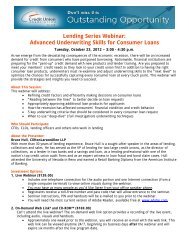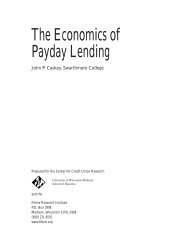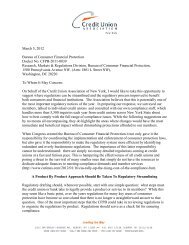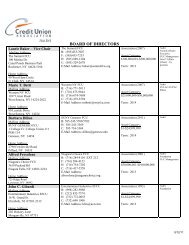Published by the Credit Union Association of New York
Published by the Credit Union Association of New York
Published by the Credit Union Association of New York
You also want an ePaper? Increase the reach of your titles
YUMPU automatically turns print PDFs into web optimized ePapers that Google loves.
• During <strong>the</strong> account review, you find that no federal<br />
benefits were directly deposited.<br />
If applicable, determine <strong>the</strong> protected amount.<br />
If <strong>the</strong>re were federal benefits directly deposited during <strong>the</strong><br />
lookback period, you must now determine <strong>the</strong> protected<br />
amount. To do this, calculate <strong>the</strong> amount <strong>of</strong> federal benefits<br />
deposited during <strong>the</strong> lookback period and compare it to <strong>the</strong><br />
account balance. The protected amount is <strong>the</strong> lesser <strong>of</strong> <strong>the</strong> two.<br />
Notify <strong>the</strong> member.<br />
Once you have determined <strong>the</strong> protected amount, you must<br />
send a notice to your member within three business days. The<br />
notice should contain, at a minimum, <strong>the</strong> following information:<br />
• notice that a garnishment was received;<br />
• <strong>the</strong> date it was received;<br />
• a simple explanation;<br />
• your credit union’s requirement to make available <strong>the</strong><br />
protected amount if a benefit agency directly deposited<br />
a benefit payment in <strong>the</strong> last two months;<br />
• <strong>the</strong> account subject to <strong>the</strong> order and <strong>the</strong> protected<br />
amount;<br />
• your credit union’s requirement pursuant to State law<br />
to freeze o<strong>the</strong>r funds in <strong>the</strong> account in order to satisfy<br />
<strong>the</strong> order;<br />
• <strong>the</strong> amount <strong>of</strong> any garnishment fee;<br />
• a list <strong>of</strong> applicable federal benefit payments;<br />
• <strong>the</strong> member’s right to claim fur<strong>the</strong>r exemption for<br />
amounts above <strong>the</strong> protected amount to <strong>the</strong> creditor;<br />
• <strong>the</strong> member’s right to consult legal counsel; and<br />
• contact information for <strong>the</strong> judgment creditor if included<br />
in <strong>the</strong> order.<br />
Final thoughts<br />
As you navigate <strong>the</strong> exciting world <strong>of</strong> garnishment orders,<br />
here are a few o<strong>the</strong>r items to keep in mind:<br />
• There are no continuing or periodic garnishment<br />
responsibilities.<br />
• A garnishment fee may not be charged against <strong>the</strong><br />
protected amount, and <strong>the</strong> fee may not be collected on<br />
funds above <strong>the</strong> protected amount after <strong>the</strong> date <strong>of</strong><br />
account review.<br />
If you want even more information on this topic, I<br />
recommend reviewing <strong>the</strong> Treasury Department’s published<br />
guidelines. You can find <strong>the</strong>m <strong>by</strong> visiting www.fms.treas.gov<br />
and searching <strong>the</strong> phrase “garnishment guidelines.” ■<br />
Michael Carter can be contacted at michael.carter@cuany.org or<br />
(800) 342-9835, ext. 8143.<br />
www.cuany.org 15






